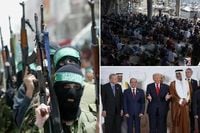In a dramatic escalation of tensions in the Middle East, the United States has issued a stark warning about an imminent threat to the fragile ceasefire in Gaza, pointing the finger squarely at Hamas. On October 18, 2025, the U.S. Department of State released a statement citing "credible reports" that Hamas is planning a "planned attack" on Palestinian civilians—an act that would constitute a direct and grave violation of the recently brokered ceasefire with Israel.
The warning, delivered via multiple channels including social media and official press releases, has reverberated through diplomatic circles. According to the U.S. State Department, "The United States has informed the guarantor nations of the Gaza peace agreement of credible reports indicating an imminent ceasefire violation by Hamas against the people of Gaza." The department added, "This planned attack against Palestinian civilians would constitute a direct and grave violation of the ceasefire agreement and undermine the significant progress achieved through mediation efforts." The U.S. also made it clear that if Hamas moves forward with such an attack, "measures will be taken to protect the people of Gaza and preserve the integrity of the ceasefire."
This latest development comes on the heels of a hard-won peace deal reached just last week, which ended Israel’s protracted military offensive in Gaza. The phased agreement, hammered out with the involvement of the United States, Egypt, Qatar, and Turkey, called for the release of Israeli hostages held by Hamas since the October 7, 2023 attacks, as well as a halt to armed conflict on both sides. The first phase of the deal, which is currently underway, involves the return of living hostages and the remains of those killed during the conflict. As reported by the Associated Press, on October 18, Hamas handed over two coffins containing deceased hostages. Israeli Prime Minister Benjamin Netanyahu’s office confirmed the bodies were being transferred to the National Institute of Forensic Medicine for identification, though no names were released. Netanyahu urged Hamas to accelerate the process, underscoring the deal’s delicate nature.
Despite the apparent progress, the situation remains fraught. The Rafah crossing—the only gateway between Gaza and the outside world—remains closed "until further notice," with Israel linking its reopening to the continued release of hostages' remains by Hamas. This closure has become a focal point for humanitarian concerns, as it prevents Gazans from seeking medical treatment abroad and keeps families separated, particularly those with relatives in Egypt. The crossing has been under Israeli control since May 2024, further complicating efforts to restore normalcy in the battered enclave.
Hamas, for its part, has accused Israel of violating the ceasefire, claiming that devastation and ongoing Israeli control in parts of Gaza have slowed the process of returning hostages’ remains. According to Fox News and Reuters, Hamas has so far returned the remains of 12 of the 28 Israeli hostages who died in Gaza. Israeli sources cited by Fox News say that most of the Palestinians recently executed by Hamas belonged to families accused of collaborating with Israel or supporting rival militias—a campaign described by officials as an attempt by Hamas to "show strength" after the ceasefire. Public executions in Gaza City’s main square have been widely reported and verified by international news agencies, painting a grim picture of the group’s efforts to reassert control over the war-torn territory.
President Donald Trump, whose administration played a central role in brokering the peace deal, has been vocal in his warnings to Hamas. On October 16, he posted on Truth Social, "If Hamas continues to kill people in Gaza, which was not the deal, we will have no choice but to go in and kill them." He later clarified to reporters that U.S. troops would not enter Gaza, but hinted that "there are people very close, very nearby that will go in, and they’ll do the trick very easily, but under our auspices." Trump’s statements have been echoed by other U.S. officials, who have stressed that the United States and other guarantor nations remain "resolute in our commitment to ensuring the safety of civilians, maintaining calm on the ground, and advancing peace and prosperity for the people of Gaza and the region as a whole."
The international dimension of the crisis cannot be overlooked. Just days before the State Department’s warning, leaders from the United States, Qatar, Turkey, and Egypt convened at an international summit in Sharm el-Sheikh, where they signed a ceasefire agreement for Gaza. Notably, neither Hamas nor Israel participated in the signing, a detail that underscores the fragility of the arrangement. The agreement followed two years of continuous conflict, sparked by Hamas’s October 7, 2023, attack on Israel—a watershed moment that set off a devastating cycle of violence.
Meanwhile, the U.S. intelligence warning has prompted urgent calls from the so-called "guarantor countries"—including Egypt and Qatar—for Hamas to uphold its obligations under the ceasefire. "The guarantors demand Hamas uphold its obligations under the ceasefire terms," the State Department reiterated in its statement, emphasizing that any breach would not only threaten the progress achieved so far but also risk plunging Gaza back into chaos.
Adding to the complexity, Jared Kushner, a former senior advisor and key figure in previous Middle East negotiations, told CBS’s 60 Minutes, "Hamas right now is doing exactly what you would expect a terrorist organization to do, which is to try to reconstitute and take back their positions." His remarks reflect a broader concern among U.S. and Israeli officials that Hamas is using the ceasefire period to consolidate power and eliminate rivals, rather than moving toward genuine peace.
The ceasefire has not only shaped the dynamics within Gaza but also reverberated across the region. On October 13, a separate ceasefire agreement was reached between Afghanistan and Pakistan after a week of deadly border clashes, with mediation led by Qatar and Turkey. This parallel effort at regional stabilization highlights the interconnectedness of conflicts in the Middle East and South Asia, and the pivotal role of international diplomacy in managing them.
Back in the United States, the ongoing crisis in Gaza has fueled domestic tensions as well. On October 19, large-scale protests erupted in over 2,600 cities under the banner "No Kings," with demonstrators voicing opposition to President Trump’s policies, including his approach to immigration, security, and the government shutdown. Trump, responding to the protests, maintained that he is "not a king," seeking to address critics of his leadership style during a period of intense scrutiny.
As Gaza teeters on the brink, the world is left watching and waiting. The next moves by Hamas—and the responses by Israel, the United States, and regional partners—could determine whether the hard-won ceasefire holds or whether the region is once again plunged into violence. The stakes, both humanitarian and geopolitical, could hardly be higher.





